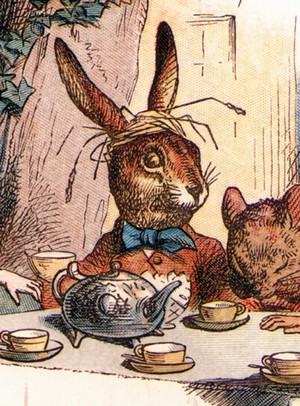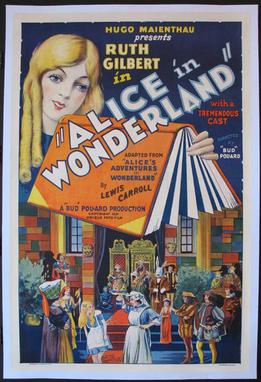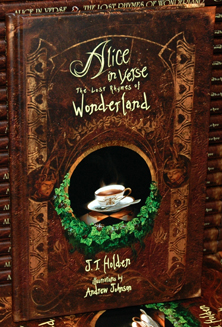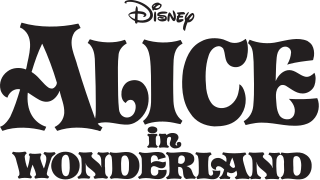
"Twinkle, Twinkle, Little Bat" is a verse recited by the Mad Hatter in chapter seven of Lewis Carroll's 1865 novel Alice's Adventures in Wonderland . It is a parody of "Twinkle Twinkle Little Star". [1]

"Twinkle, Twinkle, Little Bat" is a verse recited by the Mad Hatter in chapter seven of Lewis Carroll's 1865 novel Alice's Adventures in Wonderland . It is a parody of "Twinkle Twinkle Little Star". [1]
Twinkle, twinkle, little bat!
How I wonder what you're at!
Up above the world you fly,
Like a teatray in the sky. [2]
The Hatter is interrupted in his recitation by the Dormouse. "The Bat" was the nickname of Professor Bartholomew Price, one of the Dons at Oxford, a former teacher of Carroll's and well known to Alice Liddell's family. [1]
"Twinkle, Twinkle, Little Star" is an English lullaby. The lyrics are from an early-19th-century English poem written by Jane Taylor, "The Star". The poem, which is in couplet form, was first published in 1806 in Rhymes for the Nursery, a collection of poems by Taylor and her sister Ann. It is now sung to the tune of the French melody "Ah! vous dirai-je, maman", which was first published in 1761 and later arranged by several composers, including Mozart with Twelve Variations on "Ah vous dirai-je, Maman". The English lyrics have five stanzas, although only the first is widely known.

Alice's Adventures in Wonderland is an 1865 English children's novel by Lewis Carroll, a mathematics don at Oxford University. It details the story of a girl named Alice who falls through a rabbit hole into a fantasy world of anthropomorphic creatures. It is seen as an example of the literary nonsense genre. The artist John Tenniel provided 42 wood-engraved illustrations for the book.

The Hatter is a fictional character in Lewis Carroll's 1865 book Alice's Adventures in Wonderland and its 1871 sequel Through the Looking-Glass. He is very often referred to as the Mad Hatter, though this term was never used by Carroll. The phrase "mad as a hatter" pre-dates Carroll's works. The Hatter and the March Hare are referred to as "both mad" by the Cheshire Cat, in Alice's Adventures in Wonderland in the sixth chapter titled "Pig and Pepper".

The March Hare is a character most famous for appearing in the tea party scene in Lewis Carroll's 1865 book Alice's Adventures in Wonderland.

Adventures in Wonderland is a 1992–1995 American live-action/puppet musical television series based on the novels Alice's Adventures in Wonderland (1865) and Through the Looking-Glass (1871) by Lewis Carroll as well as the 1951 animated film. In the series, Alice, is portrayed as a girl who can come and go from Wonderland simply by walking through her mirror.

Lewis Carroll's books Alice's Adventures in Wonderland (1865) and Through the Looking-Glass (1871) have been highly popular in their original forms, and have served as the basis for many subsequent works since they were published. They have been adapted directly into other media, their characters and situations have been appropriated into other works, and these elements have been referenced innumerable times as familiar elements of shared culture. Simple references to the two books are too numerous to list; this list of works based on Alice in Wonderland focuses on works based specifically and substantially on Carroll's two books about the character of Alice.

An unbirthday is an event celebrated on all days of the year which are not a person's birthday. It is a neologism which first appeared in Lewis Carroll's 1871 novel Through the Looking-Glass. The concept gave rise to "The Unbirthday Song" in the 1951 animated feature film Alice in Wonderland.
The Looking Glass Wars is a series of three novels by Frank Beddor, heavily inspired by Lewis Carroll's 1865 novel Alice's Adventures in Wonderland and its 1871 sequel Through the Looking-Glass. The premise is that the two books written by Lewis Carroll are a distortion of the "true story".

Alice's Adventures in Wonderland is a 1972 British musical film directed by Australian filmmaker William Sterling, based on Lewis Carroll's 1865 novel of the same name and its 1871 sequel, Through the Looking-Glass. It had a distinguished ensemble cast and a musical score composed by John Barry with lyrics written by Don Black. In addition, make-up artist Stuart Freeborn created film visuals based on the original drawings by John Tenniel from the first edition of the novel.

The Dormouse is a character in "A Mad Tea-Party", Chapter VII from the 1865 novel Alice's Adventures in Wonderland by Lewis Carroll.

Alice in Wonderland is a musical by Henry Savile Clarke and Walter Slaughter (music), based on Lewis Carroll's books Alice's Adventures in Wonderland (1865) and Through the Looking-Glass (1871). It debuted at the Prince of Wales's Theatre in the West End on 23 December 1886. Aubrey Hopwood (lyrics) and Walter Slaughter (music) wrote additional songs which were first used for the 1900 revival.

Alice in Wonderland is a 1915 American silent film adaptation of Lewis Carroll's classic 1865 novel, Alice's Adventures in Wonderland, directed and written by W. W. Young and starring Viola Savoy as Alice.

Alice's Adventures in Wonderland is a 10-minute black-and-white silent film made in the United States in 1910, and is based on Lewis Carroll's 1865 book of the same name.

Alice in Wonderland (1931) is an independently made black-and-white Pre-Code American film based on Lewis Carroll's 1865 novel Alice's Adventures in Wonderland, directed by Bud Pollard, produced by Hugo Maienthau, and filmed at Metropolitan Studios in Fort Lee, New Jersey.

Alice in Verse: The Lost Rhymes of Wonderland (2010) is a reimagining of Lewis Carroll's 1865 novel Alice's Adventures in Wonderland written by British-American author J.T. Holden. It tells the story of Alice's Adventures in Wonderland in 19 rhyming poems, each written in the same style as Lewis Carroll's original verse. The book includes 36 illustrations by American artist Andrew Johnson.

The Puppy is a fictional character in Lewis Carroll's 1865 novel Alice's Adventures in Wonderland. He appears in the chapter "The Rabbit Sends a Little Bill".

Alice in Wonderland, or simply Alice, is a Disney media franchise, commencing in 1951 with the theatrical release of the animated film Alice in Wonderland. The film is an adaptation of the books by Lewis Carroll, the 1865 novel Alice's Adventures in Wonderland and its 1871 sequel Through the Looking-Glass, which featured his character Alice. A live-action film directed by Tim Burton was released in 2010.

Amy Millicent Sowerby (1878–1967) was an English painter and illustrator, known for her illustrations of classic children's stories such as Alice's Adventures in Wonderland and A Child's Garden of Verses, her postcards featuring children, nursery rhymes, and Shakespeare scenes, and children's books created with her sister Githa Sowerby.
Alice in Wonderland and Through the Looking-Glass is a 2001 stage adaptation of Lewis Carroll's 1865 novel Alice's Adventures in Wonderland, and the 1871 novel Through the Looking-Glass. It was written by Adrian Mitchell. A 2 hour adaptation of both of Carroll's novels, it holds the distinction for currently being the most comprehensive stage adaptation of the books yet made, with the endings of both novels intact and only minor changes made for theatrical staging reasons.